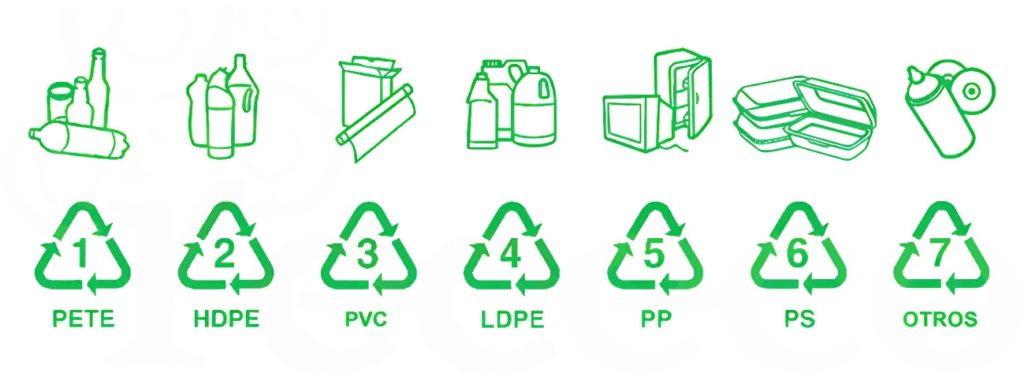Plastics recycling transcends its importance as a simple environmental responsibility; it stands as a crucial economic and technical opportunity for professionals in the field of materials engineering. With an increasing focus on sustainability, a thorough understanding of how different types of plastics are sorted and recycled is essential. This knowledge not only optimizes processes, but also opens doors to innovation in the creation of sustainable products and applications, contributing significantly to the circular economy.

Detailed Classification of Plastics
Plastics, in their diversity, are classified through numbers within the Möbius band on the recycling label, facilitating their proper separation:
PET (Polyethylene Terephthalate) – Number 1
- Properties: PET is transparent and glossy, ideal for containers that must display their contents, such as beverage bottles and food containers. It exhibits excellent tensile strength and is a good thermal insulator, suitable for various temperatures.
HDPE (High Density Polyethylene) – Number 2
- Properties: HDPE is robust, impact resistant and resistant to various chemical agents, which gives it a wide range of applications, an extensive application of this material is the packaging of cleaning products. Its opacity protects the contents from light, ideal for sensitive products.
PVC (Polyvinyl Chloride) – Number 3
- Properties: PVC offers versatility, durability and fire resistance, farbricating in both rigid and flexible forms. It is suitable for applications such as pipes, cables, floor coverings and window frames.
LDPE (Low Density Polyethylene) – Number 4
- Properties: LDPE is flexible, ideal for products requiring moldability, such as shopping bags. Its lower strength compared to HDPE makes it suitable for applications where flexibility is more important than durability.
PP (Polypropylene) – Number 5
- Properties: PP is resistant to thermal and chemical changes, maintaining its shape under mechanical stress, used in industrial and consumer applications that demand high durability.
PS (Polystyrene) – Number 6
- Properties: PS is used in rigid forms for food packaging products due to its clarity, and in expanded forms it offers insulation and light weight, although its environmental challenges require careful handling. It is a fairly versatile material.
Others – Number 7
- Properties: Includes composite plastics and bioplastics with properties designed for specific applications, such as enhanced biodegradability or specialized mechanical characteristics.

Plastics Recycling Technical Process
Plastics recycling is a painstaking process involving several essential technical steps, transforming discarded materials into valuable resources:
- Collection and Transportation
Efficiency in collection and transportation is critical. Advanced logistics systems optimize routes and maximize material compaction, reducing costs and emissions.
- Classification
Using technologies such as NIR (Near Infrared) and X-ray fluorescence, plastics are accurately sorted at recycling plants, ensuring that each type is processed properly.
- Washing and Preparation
The plastics are washed to remove contaminants and food debris, using advanced filtering technology and water treatments to ensure the purity of the recycled material.
- Crushing, Grinding and Pelletizing
The material is reduced to a uniform size, then transformed into pellets that will be the raw material for new products, facilitating handling and homogenization of the material.
- Quality Control and Application
Recycled materials undergo rigorous quality controls, including mechanical and chemical testing, to ensure that they meet the necessary standards for reuse in the manufacture of new products.
Recycled polypropylene (PP) and acrylonitrile butadiene styrene (ABS) are two of the most commonly used plastics in this sector due to their versatile properties and compatibility with the injection molding process. These materials not only offer advantages in terms of sustainability, but also provide production efficiency and cost-effectiveness for a wide range of applications.
Recycled Polypropylene (rPP) Applications
Recycled polypropylene is exceptionally versatile and is widely used in various products that require durability and resistance to continuous use:
- Furniture: rPP is used in the manufacture of garden furniture, chairs, tables and other furniture requiring weather resistance and durability.
- Durable Consumer Products: Items such as storage containers, garbage cans and household utensils benefit from the strength and easy-to-clean characteristics of rPP.
Recycled ABS Applications (rABS)
Recycled ABS retains many of the desirable characteristics of virgin ABS, making it suitable for products that require a combination of strength, aesthetics and durability:
- Household appliances: Housings and components for small appliances such as coffee makers, mixers and vacuum cleaners are often manufactured with rABS, taking advantage of its ability to be molded into complex structures with an excellent surface finish.
- Sporting Goods: Sports equipment requiring rigidity and impact resistance, such as helmets and pads, are often manufactured with rABS due to its robustness and shock absorption capacity.
- Toys and Model Making: The rABS is ideal for toys and models that require precision detailing and durability, including building blocks, action figures and scale model housings.
These applications demonstrate how recycled plastics not only meet the technical requirements of various products, but also contribute to the sustainability goals of the injection molding industry, promoting the use of renewed resources and reducing the overall environmental footprint. At Moldblade, we are committed to innovation and continuous improvement in the use of recycled materials.

